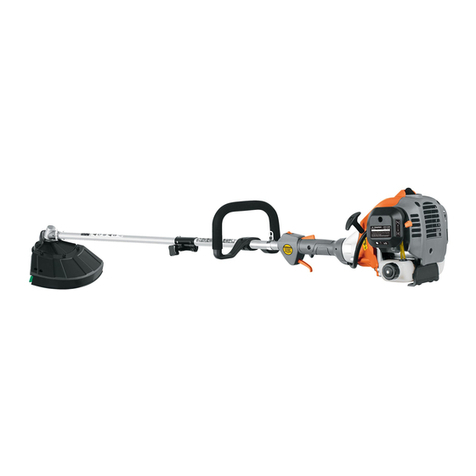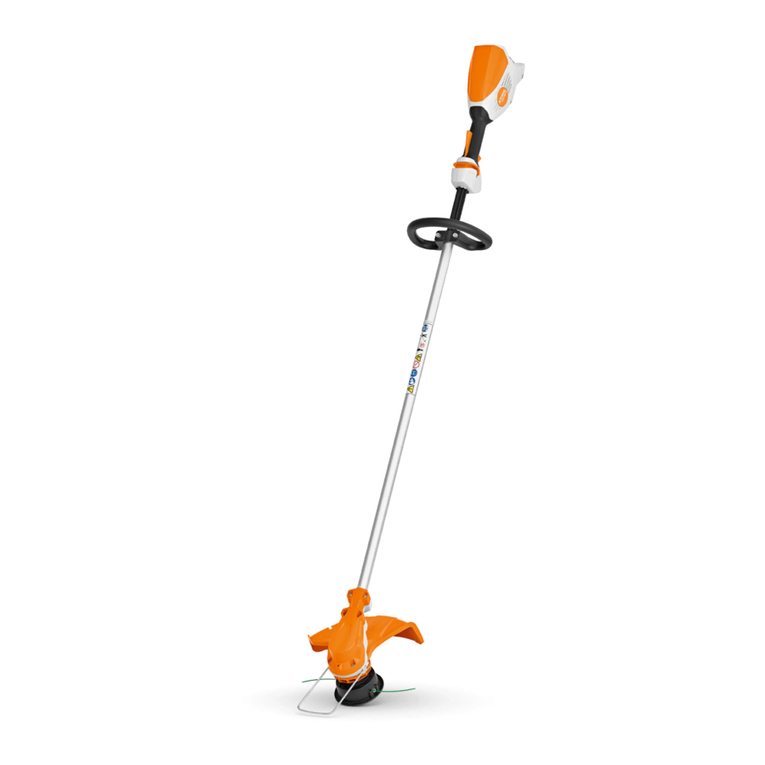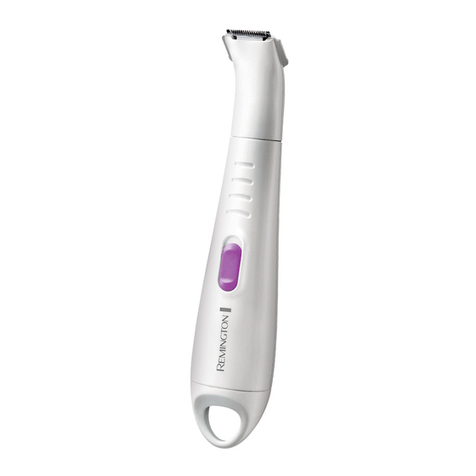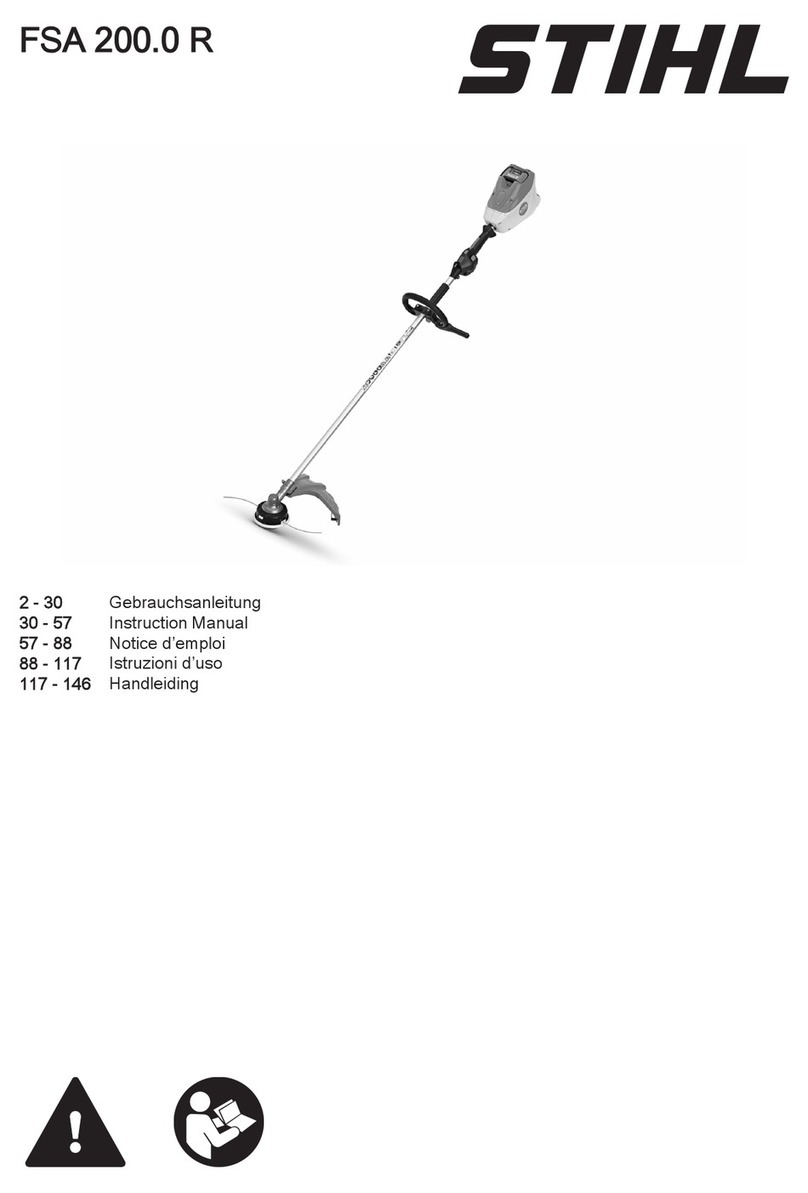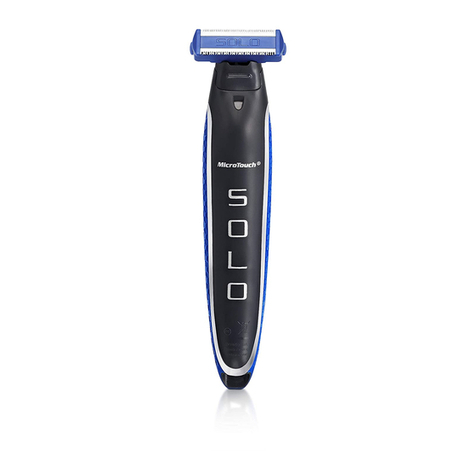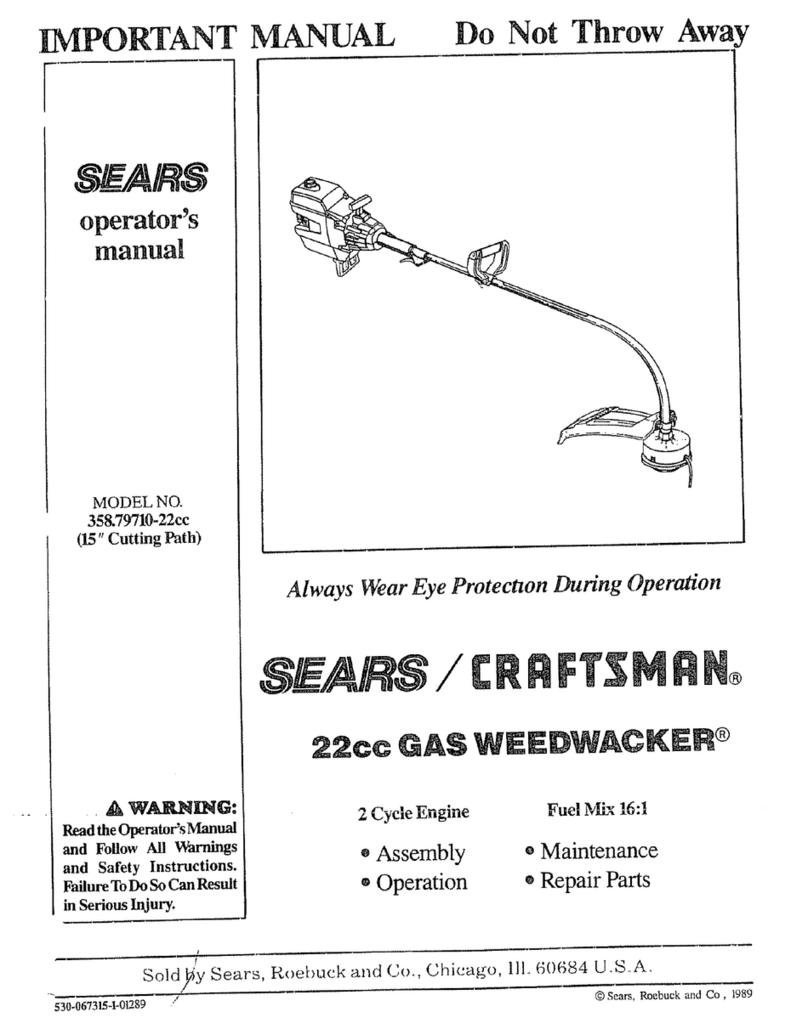Truper MAX-40C User manual

Service
Repair the tool in a Authorized Service Center
using only identical spare parts.
This will ensure that the safety of the power tool is maintained.
ModelCode
Applies for:
Manual
Cut length
40 V 26”
Cordless
Hedge Trimmer
102490 MAX-40C
CAUTION Read this manual thoroughly
before using the tool.
ENGLISH
ESPAÑOL
Work area
Keep your work area clean, and well lit.
Cluttered and dark areas may cause accidents.
Never use the tool in explosive atmospheres, such as in the
presence of flammable liquids, gases or dust.
Sparks generated by power tools may ignite the flammable material.
Keep children and bystanders at a safe distance while operating
the tool.
Distractions may cause loosing control.
Electrical Safety
The tool plug must match the power outlet. Never modify
the plug in any way. Do not use any adapter plugs with
grounded power tools.
Modified plugs and different power outlets increase the risk of electric shock.
Avoid body contact with grounded surfaces, such as pipes,
radiators, electric ranges and refrigerators.
The risk of electric shock increases if your body is grounded.
Do not expose the tool to rain or wet conditions.
Water entering into the tool increases the risk of electric shock.
Do not force the cord. Never use the cord to carry, lift or unplug
the tool. Keep the cord away from heat, oil, sharp edges or
moving parts.
Damaged or entangled cords increase the risk of electric shock.
When operating a tool outdoors, use an extension cord suitable
for outdoor use.
Using an adequate outdoor extension cord reduces the risk of electric shock.
If operating the tool in a damp location cannot be avoided, use
a ground fault circuit interrupter (GFCI) protected supply.
Using a GFCI reduces the risk of electric shock.
Personal safety
Stay alert, watch what you are doing and use common sense
when operating a tool. Do not use a power tool while you are
tired or under the influence of drugs, alcohol or medication.
A moment of distraction while operating the tool may result in personal injury.
Use personal protective equipment. Always wear eye
protection.
Protective equipment such as safety glasses, anti-dust mask, non-skid shoes,
hard hats and hearing protection used in the right conditions significantly
reduce personal injury.
Prevent unintentional starting up. Ensure the switch is in the
“OFF” position before connecting into the power source and /
or battery as well as when carrying the tool.
Transporting power tools with the finger on the switch or connecting power
tools with the switch in the “ON” position may cause accidents.
Remove any wrench or vice before turning the power tool on.
Wrenches or vices left attached to rotating parts of the tool may result in
personal injury.
Do not overreach. Keep proper footing and balance at all times.
This enables a better control on the tool during unexpected situations.
Dress properly. Do not wear loose clothing or jewelry. Keep
hair, clothes and gloves away from the moving parts.
Loose clothes or long hair may get caught in moving parts.
If you have dust extraction and recollection devices connected
onto the tool, inspect their connections and use them correctly.
Using these devices reduce dust-related risks.
Power Tools Use and Care
Do not force the tool. Use the adequate tool for your
application.
The correct tool delivers a better and safer job at the rate for which it was designed.
Do not use the tool if the switch is not working properly.
Any power tool that cannot be turned ON or OFF is dangerous and should be
repaired before operating.
Disconnect the tool from the power source and / or battery
before making any adjustments, changing accessories or
storing.
These measures reduce the risk of accidentally starting the tool.
Store tools out of the reach of children. Do not allow persons
that are not familiar with the tool or its instructions to
operate the tool.
Power tools are dangerous in the hands of untrained users.
The machine must not be used by children or persons with
reduced physical, sensory or mental capacities; nor by persons
with no experience or knowledge in its use, unless they are
supervised by a person responsible for their safety or have
received prior instructions on the use of the machine.
Children must be supervised to ensure that they do not play with the machine.
Service the tool. Check the mobile parts are not misaligned or
stuck. There should not be broken parts or other conditions that
may affect its operation. Repair any damage before using the
tool.
Most accidents are caused due to poor maintenance to the tools.
Keep the cutting accessories sharp and clean.
Cutting accessories in good working conditions are less likely to bind and are
easier to control.
Use the tool, components and accessories in accordance with
these instructions and the projected way to use it for the type of
tool when in adequate working conditions.
Using the tool for applications different from those it was designed for, could
result in a hazardous situation.
Use and care of the battery-operated tool
Recharge only with the charger specified by .
A charger that is suitable for one type of battery pack may create a risk of fire when
used with another battery pack.
Use power tools only with specifically designated battery packs.
Use of any other battery packs may create a risk of injury and fire.
When battery pack is not in use, keep it away from other metal
objects, like paper clips, coins, keys, nails, screws, or other
small metal objects, that can make a connection from one
terminal to another.
Shorting the battery terminals together may cause burns or a fire.
Under abusive conditions, liquid may be ejected from the
battery; avoid contact. If contact accidentally occurs, flush with
water. If liquid contacts eyes, additionally seek medical help.
Liquid ejected from the battery may cause irritation or burns.

Service
Repair the tool in a Authorized Service Center
using only identical spare parts.
This will ensure that the safety of the power tool is maintained.
2
Technical data
Power requirements
General power tool safety warnings
Safety warnings for the use of hedge
trimmers
Parts
Preparation
Start up
Operation
Maintenance
Environment protection
Notes
Authorized Service centers
Warranty policy
3
3
4
5
7
8
9
10
11
11
12
13
14
MAX-40C
CAUTION
Contents
Keep this manual for future references.
The illustrations in this manual are for reference
only. They might be different from the real tool.
To gain the best performance of
the tool, prolong the duty life,
make the Warranty valid if
necessary, and to avoid hazards
of fatal injuries please read and
understand this Manual before
using the tool.
Work area
Keep your work area clean, and well lit.
Cluttered and dark areas may cause accidents.
Never use the tool in explosive atmospheres, such as in the
presence of flammable liquids, gases or dust.
Sparks generated by power tools may ignite the flammable material.
Keep children and bystanders at a safe distance while operating
the tool.
Distractions may cause loosing control.
Electrical Safety
The tool plug must match the power outlet. Never modify
the plug in any way. Do not use any adapter plugs with
grounded power tools.
Modified plugs and different power outlets increase the risk of electric shock.
Avoid body contact with grounded surfaces, such as pipes,
radiators, electric ranges and refrigerators.
The risk of electric shock increases if your body is grounded.
Do not expose the tool to rain or wet conditions.
Water entering into the tool increases the risk of electric shock.
Do not force the cord. Never use the cord to carry, lift or unplug
the tool. Keep the cord away from heat, oil, sharp edges or
moving parts.
Damaged or entangled cords increase the risk of electric shock.
When operating a tool outdoors, use an extension cord suitable
for outdoor use.
Using an adequate outdoor extension cord reduces the risk of electric shock.
If operating the tool in a damp location cannot be avoided, use
a ground fault circuit interrupter (GFCI) protected supply.
Using a GFCI reduces the risk of electric shock.
Personal safety
Stay alert, watch what you are doing and use common sense
when operating a tool. Do not use a power tool while you are
tired or under the influence of drugs, alcohol or medication.
A moment of distraction while operating the tool may result in personal injury.
Use personal protective equipment. Always wear eye
protection.
Protective equipment such as safety glasses, anti-dust mask, non-skid shoes,
hard hats and hearing protection used in the right conditions significantly
reduce personal injury.
Prevent unintentional starting up. Ensure the switch is in the
“OFF” position before connecting into the power source and /
or battery as well as when carrying the tool.
Transporting power tools with the finger on the switch or connecting power
tools with the switch in the “ON” position may cause accidents.
Remove any wrench or vice before turning the power tool on.
Wrenches or vices left attached to rotating parts of the tool may result in
personal injury.
Do not overreach. Keep proper footing and balance at all times.
This enables a better control on the tool during unexpected situations.
Dress properly. Do not wear loose clothing or jewelry. Keep
hair, clothes and gloves away from the moving parts.
Loose clothes or long hair may get caught in moving parts.
If you have dust extraction and recollection devices connected
onto the tool, inspect their connections and use them correctly.
Using these devices reduce dust-related risks.
Power Tools Use and Care
Do not force the tool. Use the adequate tool for your
application.
The correct tool delivers a better and safer job at the rate for which it was designed.
Do not use the tool if the switch is not working properly.
Any power tool that cannot be turned ON or OFF is dangerous and should be
repaired before operating.
Disconnect the tool from the power source and / or battery
before making any adjustments, changing accessories or
storing.
These measures reduce the risk of accidentally starting the tool.
Store tools out of the reach of children. Do not allow persons
that are not familiar with the tool or its instructions to
operate the tool.
Power tools are dangerous in the hands of untrained users.
The machine must not be used by children or persons with
reduced physical, sensory or mental capacities; nor by persons
with no experience or knowledge in its use, unless they are
supervised by a person responsible for their safety or have
received prior instructions on the use of the machine.
Children must be supervised to ensure that they do not play with the machine.
Service the tool. Check the mobile parts are not misaligned or
stuck. There should not be broken parts or other conditions that
may affect its operation. Repair any damage before using the
tool.
Most accidents are caused due to poor maintenance to the tools.
Keep the cutting accessories sharp and clean.
Cutting accessories in good working conditions are less likely to bind and are
easier to control.
Use the tool, components and accessories in accordance with
these instructions and the projected way to use it for the type of
tool when in adequate working conditions.
Using the tool for applications different from those it was designed for, could
result in a hazardous situation.
Use and care of the battery-operated tool
Recharge only with the charger specified by .
A charger that is suitable for one type of battery pack may create a risk of fire when
used with another battery pack.
Use power tools only with specifically designated battery packs.
Use of any other battery packs may create a risk of injury and fire.
ENGLISH
When battery pack is not in use, keep it away from other metal
objects, like paper clips, coins, keys, nails, screws, or other
small metal objects, that can make a connection from one
terminal to another.
Shorting the battery terminals together may cause burns or a fire.
Under abusive conditions, liquid may be ejected from the
battery; avoid contact. If contact accidentally occurs, flush with
water. If liquid contacts eyes, additionally seek medical help.
Liquid ejected from the battery may cause irritation or burns.

Service
Repair the tool in a Authorized Service Center
using only identical spare parts.
This will ensure that the safety of the power tool is maintained.
3
MAX-40C
102490
1/2”
Cordless hedge trimmer
15/16”
Double action
Code
Description
Cut length
Voltage
Cut capacity
Blade
Distance between teeth
Batteries
Input: Tension: 127 V
Frequency: 60 Hz
Current: 2 A
Output: 21.5 V 3 A
Charger
The charger power cable has cable clamps type: Y
The construction class of the tool is: Class III
The construction class of the charger is: Reinforced insulation
40 V
Ion-lithium 20 V 4 Ah | Charging time: 1 hour 20 minutes approximately
26“
ENGLISH
Technical Data
Power Requirements
Tools with double insulation are equipped with a polarized plug
(one prong is wider than the other). This plug will only fit in the right way into a
polarized outlet. If the plug cannot be introduced into the outlet, reverse the plug. If
it still doesn’t fit, call a qualified electrician to install for you a polarized outlet. Do
not alter the plug in any way. Double insulation eliminates the need of both a
grounded third power cord with three prongs or a grounded power connection.
When using an extension cable, verify the gauge is enough for
the power that your product needs. A lower gauge cable will cause voltage drop in the line, resulting in power loss and
overheating. The following table shows the right size to use depending on cable’s length and the ampere capability shown in
the tool’s nameplate. When in doubt use the next higher gauge.
WARNING
WARNING
WARNING
from 0 A and up to 10 A
from 10 A and up to 13 A
from 13 A and up to 15 A
from 15 A and up to 20 A
18 AWG(*)
16 AWG
14 AWG
8 AWG
16 AWG
14 AWG
12 AWG
6 AWG
3 (one grounded)
from 6 ft to 49 ft | higher than 49 ft
Ampere
Capacity Number of
Conductors Extension gauge
*It is safe to use only if the extensions have a built-in artifact for over current protection.
AWG = American Wire Gauge. Reference: NMX-J-195-ANCE-2006
When operating power tools outdoors, use a grounded
extension cable labeled “For Outdoors Use”. These extensions are especially designed
for operating outdoors and reduce the risk of electric shock.
WARNING
WARNING Avoid the risk of electric shock or severe injury. When the power cable gets damaged
it should only be replaced by the manufacturer or at a Authorized Service Center.
The build quality of the electric insulation is altered if spills or liquid gets into the tool while in use.
Do not expose to rain, liquids and/or dampness.
Before gaining access to the terminals all power sources should be disconnected.
Work area
Keep your work area clean, and well lit.
Cluttered and dark areas may cause accidents.
Never use the tool in explosive atmospheres, such as in the
presence of flammable liquids, gases or dust.
Sparks generated by power tools may ignite the flammable material.
Keep children and bystanders at a safe distance while operating
the tool.
Distractions may cause loosing control.
Electrical Safety
The tool plug must match the power outlet. Never modify
the plug in any way. Do not use any adapter plugs with
grounded power tools.
Modified plugs and different power outlets increase the risk of electric shock.
Avoid body contact with grounded surfaces, such as pipes,
radiators, electric ranges and refrigerators.
The risk of electric shock increases if your body is grounded.
Do not expose the tool to rain or wet conditions.
Water entering into the tool increases the risk of electric shock.
Do not force the cord. Never use the cord to carry, lift or unplug
the tool. Keep the cord away from heat, oil, sharp edges or
moving parts.
Damaged or entangled cords increase the risk of electric shock.
When operating a tool outdoors, use an extension cord suitable
for outdoor use.
Using an adequate outdoor extension cord reduces the risk of electric shock.
If operating the tool in a damp location cannot be avoided, use
a ground fault circuit interrupter (GFCI) protected supply.
Using a GFCI reduces the risk of electric shock.
Personal safety
Stay alert, watch what you are doing and use common sense
when operating a tool. Do not use a power tool while you are
tired or under the influence of drugs, alcohol or medication.
A moment of distraction while operating the tool may result in personal injury.
Use personal protective equipment. Always wear eye
protection.
Protective equipment such as safety glasses, anti-dust mask, non-skid shoes,
hard hats and hearing protection used in the right conditions significantly
reduce personal injury.
Prevent unintentional starting up. Ensure the switch is in the
“OFF” position before connecting into the power source and /
or battery as well as when carrying the tool.
Transporting power tools with the finger on the switch or connecting power
tools with the switch in the “ON” position may cause accidents.
Remove any wrench or vice before turning the power tool on.
Wrenches or vices left attached to rotating parts of the tool may result in
personal injury.
Do not overreach. Keep proper footing and balance at all times.
This enables a better control on the tool during unexpected situations.
Dress properly. Do not wear loose clothing or jewelry. Keep
hair, clothes and gloves away from the moving parts.
Loose clothes or long hair may get caught in moving parts.
If you have dust extraction and recollection devices connected
onto the tool, inspect their connections and use them correctly.
Using these devices reduce dust-related risks.
Power Tools Use and Care
Do not force the tool. Use the adequate tool for your
application.
The correct tool delivers a better and safer job at the rate for which it was designed.
Do not use the tool if the switch is not working properly.
Any power tool that cannot be turned ON or OFF is dangerous and should be
repaired before operating.
Disconnect the tool from the power source and / or battery
before making any adjustments, changing accessories or
storing.
These measures reduce the risk of accidentally starting the tool.
Store tools out of the reach of children. Do not allow persons
that are not familiar with the tool or its instructions to
operate the tool.
Power tools are dangerous in the hands of untrained users.
The machine must not be used by children or persons with
reduced physical, sensory or mental capacities; nor by persons
with no experience or knowledge in its use, unless they are
supervised by a person responsible for their safety or have
received prior instructions on the use of the machine.
Children must be supervised to ensure that they do not play with the machine.
Service the tool. Check the mobile parts are not misaligned or
stuck. There should not be broken parts or other conditions that
may affect its operation. Repair any damage before using the
tool.
Most accidents are caused due to poor maintenance to the tools.
Keep the cutting accessories sharp and clean.
Cutting accessories in good working conditions are less likely to bind and are
easier to control.
Use the tool, components and accessories in accordance with
these instructions and the projected way to use it for the type of
tool when in adequate working conditions.
Using the tool for applications different from those it was designed for, could
result in a hazardous situation.
Use and care of the battery-operated tool
Recharge only with the charger specified by .
A charger that is suitable for one type of battery pack may create a risk of fire when
used with another battery pack.
Use power tools only with specifically designated battery packs.
Use of any other battery packs may create a risk of injury and fire.
When battery pack is not in use, keep it away from other metal
objects, like paper clips, coins, keys, nails, screws, or other
small metal objects, that can make a connection from one
terminal to another.
Shorting the battery terminals together may cause burns or a fire.
Under abusive conditions, liquid may be ejected from the
battery; avoid contact. If contact accidentally occurs, flush with
water. If liquid contacts eyes, additionally seek medical help.
Liquid ejected from the battery may cause irritation or burns.

Service
Repair the tool in a Authorized Service Center
using only identical spare parts.
This will ensure that the safety of the power tool is maintained.
4
General power tools
safety warnings
ENGLISH This tool is in compliance with the Official Mexican Standard (NOM - Norma Oficial Mexicana).
Work area
Keep your work area clean, and well lit.
Cluttered and dark areas may cause accidents.
Never use the tool in explosive atmospheres, such as in the
presence of flammable liquids, gases or dust.
Sparks generated by power tools may ignite the flammable material.
Keep children and bystanders at a safe distance while operating
the tool.
Distractions may cause loosing control.
Electrical Safety
The tool plug must match the power outlet. Never modify
the plug in any way. Do not use any adapter plugs with
grounded power tools.
Modified plugs and different power outlets increase the risk of electric shock.
Avoid body contact with grounded surfaces, such as pipes,
radiators, electric ranges and refrigerators.
The risk of electric shock increases if your body is grounded.
Do not expose the tool to rain or wet conditions.
Water entering into the tool increases the risk of electric shock.
Do not force the cord. Never use the cord to carry, lift or unplug
the tool. Keep the cord away from heat, oil, sharp edges or
moving parts.
Damaged or entangled cords increase the risk of electric shock.
When operating a tool outdoors, use an extension cord suitable
for outdoor use.
Using an adequate outdoor extension cord reduces the risk of electric shock.
If operating the tool in a damp location cannot be avoided, use
a ground fault circuit interrupter (GFCI) protected supply.
Using a GFCI reduces the risk of electric shock.
Personal safety
Stay alert, watch what you are doing and use common sense
when operating a tool. Do not use a power tool while you are
tired or under the influence of drugs, alcohol or medication.
A moment of distraction while operating the tool may result in personal injury.
Use personal protective equipment. Always wear eye
protection.
Protective equipment such as safety glasses, anti-dust mask, non-skid shoes,
hard hats and hearing protection used in the right conditions significantly
reduce personal injury.
Prevent unintentional starting up. Ensure the switch is in the
“OFF” position before connecting into the power source and /
or battery as well as when carrying the tool.
Transporting power tools with the finger on the switch or connecting power
tools with the switch in the “ON” position may cause accidents.
Remove any wrench or vice before turning the power tool on.
Wrenches or vices left attached to rotating parts of the tool may result in
personal injury.
Do not overreach. Keep proper footing and balance at all times.
This enables a better control on the tool during unexpected situations.
Dress properly. Do not wear loose clothing or jewelry. Keep
hair, clothes and gloves away from the moving parts.
Loose clothes or long hair may get caught in moving parts.
If you have dust extraction and recollection devices connected
onto the tool, inspect their connections and use them correctly.
Using these devices reduce dust-related risks.
Power Tools Use and Care
Do not force the tool. Use the adequate tool for your
application.
The correct tool delivers a better and safer job at the rate for which it was designed.
Do not use the tool if the switch is not working properly.
Any power tool that cannot be turned ON or OFF is dangerous and should be
repaired before operating.
Disconnect the tool from the power source and / or battery
before making any adjustments, changing accessories or
storing.
These measures reduce the risk of accidentally starting the tool.
Store tools out of the reach of children. Do not allow persons
that are not familiar with the tool or its instructions to
operate the tool.
Power tools are dangerous in the hands of untrained users.
The machine must not be used by children or persons with
reduced physical, sensory or mental capacities; nor by persons
with no experience or knowledge in its use, unless they are
supervised by a person responsible for their safety or have
received prior instructions on the use of the machine.
Children must be supervised to ensure that they do not play with the machine.
Service the tool. Check the mobile parts are not misaligned or
stuck. There should not be broken parts or other conditions that
may affect its operation. Repair any damage before using the
tool.
Most accidents are caused due to poor maintenance to the tools.
Keep the cutting accessories sharp and clean.
Cutting accessories in good working conditions are less likely to bind and are
easier to control.
Use the tool, components and accessories in accordance with
these instructions and the projected way to use it for the type of
tool when in adequate working conditions.
Using the tool for applications different from those it was designed for, could
result in a hazardous situation.
Use and care of the battery-operated tool
Recharge only with the charger specified by .
A charger that is suitable for one type of battery pack may create a risk of fire when
used with another battery pack.
Use power tools only with specifically designated battery packs.
Use of any other battery packs may create a risk of injury and fire.
WARNING! Read carefully all safety warnings and instruction listed below. Failure to comply with any of
these warnings may result in electric shock, fire and / or severe damage. Save all warnings and instructions for
future references.
When battery pack is not in use, keep it away from other metal
objects, like paper clips, coins, keys, nails, screws, or other
small metal objects, that can make a connection from one
terminal to another.
Shorting the battery terminals together may cause burns or a fire.
Under abusive conditions, liquid may be ejected from the
battery; avoid contact. If contact accidentally occurs, flush with
water. If liquid contacts eyes, additionally seek medical help.
Liquid ejected from the battery may cause irritation or burns.

Service
Repair the tool in a Authorized Service Center
using only identical spare parts.
This will ensure that the safety of the power tool is maintained.
5
• Use only Truper Max chargers to charge
the tool battery. Using any other charger may result in fire
or risk of injury.
• Use only batteries specifically designed
for the tool. Other batteries may create a risk of fire or
explosion.
• Connect the charger to an alternating current (AC) supply
only.
• Do not use the charger outdoors.
• Watch polarity “+/-” when charging.
• Never recharge a leaking battery.
• Do not use batteries or the charger for purposes other
than those for which they were designed.
• Do not modify the contacts of the battery or the charger.
• Do not expose the batteries to temperatures above
122 °C.
• Never expose batteries to fire, they could
explode.
• Batteries should be kept away from any
metallic object such as paper clips, coins, keys, nails,
screws or any other object that could cause the terminals
to make contact, since it would cause a short circuit that
could cause burns or fire.
• Under extreme conditions, battery fluid
may leak. If so, avoid any contact. If accidental contact
occurs, wash with abundant water, rinse with lemon juice
and vinegar. If the liquid enters in contact with the eyes,
wash with abundant water during several minutes and look
for medical help immediately. The liquid expelled from the
batteries could cause irradiation or burns.
• To maximize battery life, fully discharge
the battery at least once a month. Do not leave the battery
uncharged for more than three months. Always charge the
battery to its maximum capacity. Before using the machine
for the first time, charge the battery for a minimum of 1.5
hours.
Batteries and charger
• Safety is a combination of common sense, an alert mind and knowledge of how the tool works.
• Read the manual carefully before starting to use the tool. Pay CAUTION to the safety rules, warning
symbols and danger, caution and warning notices in the manual and on the labels attached to the tool.
• The tool is designed for bush cutting only. Do not attempt to cut other types of material.
Before operating the tool
• Do not use the tool in the rain or in wet conditions. The
electric motor is not waterproof.
• Novice users should be trained by an experienced user
in the use of the tool.
• The tool should not be used by children or persons
under 18 years of age. Persons over 16 years of age may
do so if they are trained under the supervision of an
expert.
• Never use the tool when you are tired,
ill or under the influence of drugs, alcohol or medication.
• Wear appropriate clothing to operate
the tool: tight fitting clothing, heavy-duty protective gloves
and safety glasses with side shields in accordance with
ANSI Z871.
• Make sure the tool is in perfect condition for safe use.
Do not turn it on if it is improperly adjusted or not fully
assembled or has any loose bolts.
• Do not use the tool without the protective guards
properly mounted and secured.
• Check the work area and remove any stones, glass, nails,
wires, ropes or any foreign objects. They could be thrown
or become entangled in the tool.
• Make sure visibility and light conditions are adequate to
see clearly, otherwise do not use the tool.
Work area
Keep your work area clean, and well lit.
Cluttered and dark areas may cause accidents.
Never use the tool in explosive atmospheres, such as in the
presence of flammable liquids, gases or dust.
Sparks generated by power tools may ignite the flammable material.
Keep children and bystanders at a safe distance while operating
the tool.
Distractions may cause loosing control.
Electrical Safety
The tool plug must match the power outlet. Never modify
the plug in any way. Do not use any adapter plugs with
grounded power tools.
Modified plugs and different power outlets increase the risk of electric shock.
Avoid body contact with grounded surfaces, such as pipes,
radiators, electric ranges and refrigerators.
The risk of electric shock increases if your body is grounded.
Do not expose the tool to rain or wet conditions.
Water entering into the tool increases the risk of electric shock.
Do not force the cord. Never use the cord to carry, lift or unplug
the tool. Keep the cord away from heat, oil, sharp edges or
moving parts.
Damaged or entangled cords increase the risk of electric shock.
When operating a tool outdoors, use an extension cord suitable
for outdoor use.
Using an adequate outdoor extension cord reduces the risk of electric shock.
If operating the tool in a damp location cannot be avoided, use
a ground fault circuit interrupter (GFCI) protected supply.
Using a GFCI reduces the risk of electric shock.
Personal safety
Stay alert, watch what you are doing and use common sense
when operating a tool. Do not use a power tool while you are
tired or under the influence of drugs, alcohol or medication.
A moment of distraction while operating the tool may result in personal injury.
Use personal protective equipment. Always wear eye
protection.
Protective equipment such as safety glasses, anti-dust mask, non-skid shoes,
hard hats and hearing protection used in the right conditions significantly
reduce personal injury.
Prevent unintentional starting up. Ensure the switch is in the
“OFF” position before connecting into the power source and /
or battery as well as when carrying the tool.
Transporting power tools with the finger on the switch or connecting power
tools with the switch in the “ON” position may cause accidents.
Remove any wrench or vice before turning the power tool on.
Wrenches or vices left attached to rotating parts of the tool may result in
personal injury.
Do not overreach. Keep proper footing and balance at all times.
This enables a better control on the tool during unexpected situations.
Dress properly. Do not wear loose clothing or jewelry. Keep
hair, clothes and gloves away from the moving parts.
Loose clothes or long hair may get caught in moving parts.
If you have dust extraction and recollection devices connected
onto the tool, inspect their connections and use them correctly.
Using these devices reduce dust-related risks.
Power Tools Use and Care
Do not force the tool. Use the adequate tool for your
application.
The correct tool delivers a better and safer job at the rate for which it was designed.
Do not use the tool if the switch is not working properly.
Any power tool that cannot be turned ON or OFF is dangerous and should be
repaired before operating.
Disconnect the tool from the power source and / or battery
before making any adjustments, changing accessories or
storing.
These measures reduce the risk of accidentally starting the tool.
Store tools out of the reach of children. Do not allow persons
that are not familiar with the tool or its instructions to
operate the tool.
Power tools are dangerous in the hands of untrained users.
The machine must not be used by children or persons with
reduced physical, sensory or mental capacities; nor by persons
with no experience or knowledge in its use, unless they are
supervised by a person responsible for their safety or have
received prior instructions on the use of the machine.
Children must be supervised to ensure that they do not play with the machine.
Service the tool. Check the mobile parts are not misaligned or
stuck. There should not be broken parts or other conditions that
may affect its operation. Repair any damage before using the
tool.
Most accidents are caused due to poor maintenance to the tools.
Keep the cutting accessories sharp and clean.
Cutting accessories in good working conditions are less likely to bind and are
easier to control.
Use the tool, components and accessories in accordance with
these instructions and the projected way to use it for the type of
tool when in adequate working conditions.
Using the tool for applications different from those it was designed for, could
result in a hazardous situation.
Use and care of the battery-operated tool
Recharge only with the charger specified by .
A charger that is suitable for one type of battery pack may create a risk of fire when
used with another battery pack.
Use power tools only with specifically designated battery packs.
Use of any other battery packs may create a risk of injury and fire.
DANGER
DANGER
DANGER
DANGER
DANGER
CAUTION
CAUTION
CAUTION
CAUTION
CAUTION
WARNING
Safety rules for the use
of hedge trimmers
ENGLISH
• Avoid stopping constantly while operating the tool to
prevent damage to the battery.
• Do not dispose of batteries in fire, the battery may
explode. Consult local codes for possible special disposal
instructions.
• Do not open or mutilate batteries. Released electrolyte is
corrosive and may cause eye or skin damage. May be
toxic if swallowed.
• Do not charge the battery in the rain or in damp places.
When battery pack is not in use, keep it away from other metal
objects, like paper clips, coins, keys, nails, screws, or other
small metal objects, that can make a connection from one
terminal to another.
Shorting the battery terminals together may cause burns or a fire.
Under abusive conditions, liquid may be ejected from the
battery; avoid contact. If contact accidentally occurs, flush with
water. If liquid contacts eyes, additionally seek medical help.
Liquid ejected from the battery may cause irritation or burns.

Service
Repair the tool in a Authorized Service Center
using only identical spare parts.
This will ensure that the safety of the power tool is maintained.
6
When operating the tool After operating the tool
• Keep all parts of the body away from the cutting blade.
Do not remove the cut material or hold the material to be
cut when the blades are moving. Make sure the switch is
off when removing jammed material.
• Hold the tool by insulated gripping surfaces only, as the
cutting blade may contact hidden electrical wiring to
prevent possible electrical shock.
• Keep hands away from the blade.
Contact with the blade will result in serious personal
injury.
• Keep both feet firmly on the floor and
both hands holding the tool by the handles. Never
operate the tool with only one hand, otherwise the
operator and others present may be injured.
• If the blade comes in contact with a
fence or any other hard object, immediately turn off the
engine and remove the battery cartridge. Check the blade
for damage and, if damaged, repair it immediately.
• Before checking the tool, servicing, repairing faults or
removing material caught in the blade, always switch off
the tool and remove the battery cartridge.
• Never point the blades at yourself or
others.
• If the blades become jammed during
operation, turn the tool off and remove the battery
cartridge, then remove foreign objects using a tool such
as pliers. Do not do this by hand as the blades may move
when removing foreign objects and cause injury.
• When moving, even while working, or storing the tool,
turn off the motor, remove the batteries and replace the
blade sheath.
• Clean the tool, and especially the blade, after use and
before long-term storage. Lightly oil the blade and replace
the sheath.
• Store the tool with its sheath on, in a dry place, out of
the reach of children. Never store the tool outdoors.
Work area
Keep your work area clean, and well lit.
Cluttered and dark areas may cause accidents.
Never use the tool in explosive atmospheres, such as in the
presence of flammable liquids, gases or dust.
Sparks generated by power tools may ignite the flammable material.
Keep children and bystanders at a safe distance while operating
the tool.
Distractions may cause loosing control.
Electrical Safety
The tool plug must match the power outlet. Never modify
the plug in any way. Do not use any adapter plugs with
grounded power tools.
Modified plugs and different power outlets increase the risk of electric shock.
Avoid body contact with grounded surfaces, such as pipes,
radiators, electric ranges and refrigerators.
The risk of electric shock increases if your body is grounded.
Do not expose the tool to rain or wet conditions.
Water entering into the tool increases the risk of electric shock.
Do not force the cord. Never use the cord to carry, lift or unplug
the tool. Keep the cord away from heat, oil, sharp edges or
moving parts.
Damaged or entangled cords increase the risk of electric shock.
When operating a tool outdoors, use an extension cord suitable
for outdoor use.
Using an adequate outdoor extension cord reduces the risk of electric shock.
If operating the tool in a damp location cannot be avoided, use
a ground fault circuit interrupter (GFCI) protected supply.
Using a GFCI reduces the risk of electric shock.
Personal safety
Stay alert, watch what you are doing and use common sense
when operating a tool. Do not use a power tool while you are
tired or under the influence of drugs, alcohol or medication.
A moment of distraction while operating the tool may result in personal injury.
Use personal protective equipment. Always wear eye
protection.
Protective equipment such as safety glasses, anti-dust mask, non-skid shoes,
hard hats and hearing protection used in the right conditions significantly
reduce personal injury.
Prevent unintentional starting up. Ensure the switch is in the
“OFF” position before connecting into the power source and /
or battery as well as when carrying the tool.
Transporting power tools with the finger on the switch or connecting power
tools with the switch in the “ON” position may cause accidents.
Remove any wrench or vice before turning the power tool on.
Wrenches or vices left attached to rotating parts of the tool may result in
personal injury.
Do not overreach. Keep proper footing and balance at all times.
This enables a better control on the tool during unexpected situations.
Dress properly. Do not wear loose clothing or jewelry. Keep
hair, clothes and gloves away from the moving parts.
Loose clothes or long hair may get caught in moving parts.
If you have dust extraction and recollection devices connected
onto the tool, inspect their connections and use them correctly.
Using these devices reduce dust-related risks.
Power Tools Use and Care
Do not force the tool. Use the adequate tool for your
application.
The correct tool delivers a better and safer job at the rate for which it was designed.
Do not use the tool if the switch is not working properly.
Any power tool that cannot be turned ON or OFF is dangerous and should be
repaired before operating.
Disconnect the tool from the power source and / or battery
before making any adjustments, changing accessories or
storing.
These measures reduce the risk of accidentally starting the tool.
Store tools out of the reach of children. Do not allow persons
that are not familiar with the tool or its instructions to
operate the tool.
Power tools are dangerous in the hands of untrained users.
The machine must not be used by children or persons with
reduced physical, sensory or mental capacities; nor by persons
with no experience or knowledge in its use, unless they are
supervised by a person responsible for their safety or have
received prior instructions on the use of the machine.
Children must be supervised to ensure that they do not play with the machine.
Service the tool. Check the mobile parts are not misaligned or
stuck. There should not be broken parts or other conditions that
may affect its operation. Repair any damage before using the
tool.
Most accidents are caused due to poor maintenance to the tools.
Keep the cutting accessories sharp and clean.
Cutting accessories in good working conditions are less likely to bind and are
easier to control.
Use the tool, components and accessories in accordance with
these instructions and the projected way to use it for the type of
tool when in adequate working conditions.
Using the tool for applications different from those it was designed for, could
result in a hazardous situation.
Use and care of the battery-operated tool
Recharge only with the charger specified by .
A charger that is suitable for one type of battery pack may create a risk of fire when
used with another battery pack.
Use power tools only with specifically designated battery packs.
Use of any other battery packs may create a risk of injury and fire.
DANGER
CAUTION
CAUTION
WARNING
WARNING
Safety rules for the use
of hedge trimmers
ENGLISH
When battery pack is not in use, keep it away from other metal
objects, like paper clips, coins, keys, nails, screws, or other
small metal objects, that can make a connection from one
terminal to another.
Shorting the battery terminals together may cause burns or a fire.
Under abusive conditions, liquid may be ejected from the
battery; avoid contact. If contact accidentally occurs, flush with
water. If liquid contacts eyes, additionally seek medical help.
Liquid ejected from the battery may cause irritation or burns.

Service
Repair the tool in a Authorized Service Center
using only identical spare parts.
This will ensure that the safety of the power tool is maintained.
7
Upper
blade teeth
Lower blade
teeth
Parts
Bar
Battery release
buttons
Trigger
switch lock
Battery
receptacle
Ventilation
slots
Double
action blade
Blade sheath
Battery charger
Batteries
Handle
Trigger switch
Auxiliary
handle
Handle angle
lock button
Guard
Auxiliary
handle
Guard
Work area
Keep your work area clean, and well lit.
Cluttered and dark areas may cause accidents.
Never use the tool in explosive atmospheres, such as in the
presence of flammable liquids, gases or dust.
Sparks generated by power tools may ignite the flammable material.
Keep children and bystanders at a safe distance while operating
the tool.
Distractions may cause loosing control.
Electrical Safety
The tool plug must match the power outlet. Never modify
the plug in any way. Do not use any adapter plugs with
grounded power tools.
Modified plugs and different power outlets increase the risk of electric shock.
Avoid body contact with grounded surfaces, such as pipes,
radiators, electric ranges and refrigerators.
The risk of electric shock increases if your body is grounded.
Do not expose the tool to rain or wet conditions.
Water entering into the tool increases the risk of electric shock.
Do not force the cord. Never use the cord to carry, lift or unplug
the tool. Keep the cord away from heat, oil, sharp edges or
moving parts.
Damaged or entangled cords increase the risk of electric shock.
When operating a tool outdoors, use an extension cord suitable
for outdoor use.
Using an adequate outdoor extension cord reduces the risk of electric shock.
If operating the tool in a damp location cannot be avoided, use
a ground fault circuit interrupter (GFCI) protected supply.
Using a GFCI reduces the risk of electric shock.
Personal safety
Stay alert, watch what you are doing and use common sense
when operating a tool. Do not use a power tool while you are
tired or under the influence of drugs, alcohol or medication.
A moment of distraction while operating the tool may result in personal injury.
Use personal protective equipment. Always wear eye
protection.
Protective equipment such as safety glasses, anti-dust mask, non-skid shoes,
hard hats and hearing protection used in the right conditions significantly
reduce personal injury.
Prevent unintentional starting up. Ensure the switch is in the
“OFF” position before connecting into the power source and /
or battery as well as when carrying the tool.
Transporting power tools with the finger on the switch or connecting power
tools with the switch in the “ON” position may cause accidents.
Remove any wrench or vice before turning the power tool on.
Wrenches or vices left attached to rotating parts of the tool may result in
personal injury.
Do not overreach. Keep proper footing and balance at all times.
This enables a better control on the tool during unexpected situations.
Dress properly. Do not wear loose clothing or jewelry. Keep
hair, clothes and gloves away from the moving parts.
Loose clothes or long hair may get caught in moving parts.
If you have dust extraction and recollection devices connected
onto the tool, inspect their connections and use them correctly.
Using these devices reduce dust-related risks.
Power Tools Use and Care
Do not force the tool. Use the adequate tool for your
application.
The correct tool delivers a better and safer job at the rate for which it was designed.
Do not use the tool if the switch is not working properly.
Any power tool that cannot be turned ON or OFF is dangerous and should be
repaired before operating.
Disconnect the tool from the power source and / or battery
before making any adjustments, changing accessories or
storing.
These measures reduce the risk of accidentally starting the tool.
Store tools out of the reach of children. Do not allow persons
that are not familiar with the tool or its instructions to
operate the tool.
Power tools are dangerous in the hands of untrained users.
The machine must not be used by children or persons with
reduced physical, sensory or mental capacities; nor by persons
with no experience or knowledge in its use, unless they are
supervised by a person responsible for their safety or have
received prior instructions on the use of the machine.
Children must be supervised to ensure that they do not play with the machine.
Service the tool. Check the mobile parts are not misaligned or
stuck. There should not be broken parts or other conditions that
may affect its operation. Repair any damage before using the
tool.
Most accidents are caused due to poor maintenance to the tools.
Keep the cutting accessories sharp and clean.
Cutting accessories in good working conditions are less likely to bind and are
easier to control.
Use the tool, components and accessories in accordance with
these instructions and the projected way to use it for the type of
tool when in adequate working conditions.
Using the tool for applications different from those it was designed for, could
result in a hazardous situation.
Use and care of the battery-operated tool
Recharge only with the charger specified by .
A charger that is suitable for one type of battery pack may create a risk of fire when
used with another battery pack.
Use power tools only with specifically designated battery packs.
Use of any other battery packs may create a risk of injury and fire.
ENGLISH
When battery pack is not in use, keep it away from other metal
objects, like paper clips, coins, keys, nails, screws, or other
small metal objects, that can make a connection from one
terminal to another.
Shorting the battery terminals together may cause burns or a fire.
Under abusive conditions, liquid may be ejected from the
battery; avoid contact. If contact accidentally occurs, flush with
water. If liquid contacts eyes, additionally seek medical help.
Liquid ejected from the battery may cause irritation or burns.

Service
Repair the tool in a Authorized Service Center
using only identical spare parts.
This will ensure that the safety of the power tool is maintained.
8
Preparation
Considerations for the use of batteries
Batteries charge
• The batteries come DISCHARGED from the factory. They
will need to be charged for approximately 1.5 hours before
use.
• The normal charging temperature is from 32 °F to 113 °F.
Out of that range the load is suspended automatically until it
reaches the correct temperature, he normal discharge /
working temperature is 32 °F to 167 °F. If 167 °F is exceeded
the electronic control shuts off power to the tool until the
temperature reaches the optimum temperature range again.
When the battery is under normal voltage during work, the
tool stops working.
• Between each charge, give the charger 15 minutes of rest.
• In a hot environment or after prolonged use, the battery
may become too hot to recharge. Allow the battery to cool
down before attempting to recharge it.
1. Connect the charger plug to a 127 V~.
2. Insert the batteries into the charger by sliding them as
shown in the picture. The red light should illuminate,
indicating that charging has started.
• When the batteries are fully charged, the green light will
turn on and the red light will turn off.
• Disconnect the charger from the power supply when
charging is complete.
• If the red-light remains on exceeding the recommended
charging time or if the red and green light flash alternately
it is a sign that the battery is defective. Replace it with a
new one.
• If the red-light flashes it is a sign that the battery
temperature is below 32 °F or above 113 °F. Wait until the
battery temperature is in the proper range to charge the
battery. 1
2
A
• Once the batteries are charged, insert them into their
respective receptacles under the main handle.
• Slide the battery into its socket until you hear a click to
make sure they are seated properly.
• To remove the battery, press the latch (A) and slide the
battery out.
• To make sure the batteries are charged, press the
indicator button (B) next to each battery. The color of the
light indicates the charge level.
Batteries
B
Work area
Keep your work area clean, and well lit.
Cluttered and dark areas may cause accidents.
Never use the tool in explosive atmospheres, such as in the
presence of flammable liquids, gases or dust.
Sparks generated by power tools may ignite the flammable material.
Keep children and bystanders at a safe distance while operating
the tool.
Distractions may cause loosing control.
Electrical Safety
The tool plug must match the power outlet. Never modify
the plug in any way. Do not use any adapter plugs with
grounded power tools.
Modified plugs and different power outlets increase the risk of electric shock.
Avoid body contact with grounded surfaces, such as pipes,
radiators, electric ranges and refrigerators.
The risk of electric shock increases if your body is grounded.
Do not expose the tool to rain or wet conditions.
Water entering into the tool increases the risk of electric shock.
Do not force the cord. Never use the cord to carry, lift or unplug
the tool. Keep the cord away from heat, oil, sharp edges or
moving parts.
Damaged or entangled cords increase the risk of electric shock.
When operating a tool outdoors, use an extension cord suitable
for outdoor use.
Using an adequate outdoor extension cord reduces the risk of electric shock.
If operating the tool in a damp location cannot be avoided, use
a ground fault circuit interrupter (GFCI) protected supply.
Using a GFCI reduces the risk of electric shock.
Personal safety
Stay alert, watch what you are doing and use common sense
when operating a tool. Do not use a power tool while you are
tired or under the influence of drugs, alcohol or medication.
A moment of distraction while operating the tool may result in personal injury.
Use personal protective equipment. Always wear eye
protection.
Protective equipment such as safety glasses, anti-dust mask, non-skid shoes,
hard hats and hearing protection used in the right conditions significantly
reduce personal injury.
Prevent unintentional starting up. Ensure the switch is in the
“OFF” position before connecting into the power source and /
or battery as well as when carrying the tool.
Transporting power tools with the finger on the switch or connecting power
tools with the switch in the “ON” position may cause accidents.
Remove any wrench or vice before turning the power tool on.
Wrenches or vices left attached to rotating parts of the tool may result in
personal injury.
Do not overreach. Keep proper footing and balance at all times.
This enables a better control on the tool during unexpected situations.
Dress properly. Do not wear loose clothing or jewelry. Keep
hair, clothes and gloves away from the moving parts.
Loose clothes or long hair may get caught in moving parts.
If you have dust extraction and recollection devices connected
onto the tool, inspect their connections and use them correctly.
Using these devices reduce dust-related risks.
Power Tools Use and Care
Do not force the tool. Use the adequate tool for your
application.
The correct tool delivers a better and safer job at the rate for which it was designed.
Do not use the tool if the switch is not working properly.
Any power tool that cannot be turned ON or OFF is dangerous and should be
repaired before operating.
Disconnect the tool from the power source and / or battery
before making any adjustments, changing accessories or
storing.
These measures reduce the risk of accidentally starting the tool.
Store tools out of the reach of children. Do not allow persons
that are not familiar with the tool or its instructions to
operate the tool.
Power tools are dangerous in the hands of untrained users.
The machine must not be used by children or persons with
reduced physical, sensory or mental capacities; nor by persons
with no experience or knowledge in its use, unless they are
supervised by a person responsible for their safety or have
received prior instructions on the use of the machine.
Children must be supervised to ensure that they do not play with the machine.
Service the tool. Check the mobile parts are not misaligned or
stuck. There should not be broken parts or other conditions that
may affect its operation. Repair any damage before using the
tool.
Most accidents are caused due to poor maintenance to the tools.
Keep the cutting accessories sharp and clean.
Cutting accessories in good working conditions are less likely to bind and are
easier to control.
Use the tool, components and accessories in accordance with
these instructions and the projected way to use it for the type of
tool when in adequate working conditions.
Using the tool for applications different from those it was designed for, could
result in a hazardous situation.
Use and care of the battery-operated tool
Recharge only with the charger specified by .
A charger that is suitable for one type of battery pack may create a risk of fire when
used with another battery pack.
Use power tools only with specifically designated battery packs.
Use of any other battery packs may create a risk of injury and fire.
• The tool is equipped with a system that
automatically stops the tool to prolong both its useful life and
that of the batteries, this happens in the following cases:
Overload. When the tool is forced, the battery consumes
abnormally high current levels. Suspend overexertion work
and turn the tool back on.
Overheating. Let the tool and battery cool before turning it
back on.
Over-discharge. The battery level is low. In this case,
remove the battery from the tool and charge it.
Tool/batteries protection system
CAUTION
NOTE: Depending on the conditions of use and ambient
temperature, the indication may differ slightly from the
actual capacity.
Remaining battery capacity
Indicator
lamp
Illuminated
OFF
Green
Orange
Red
51% to 100%
Orange
Red
26% to 50%
Red
10% to 25%
ENGLISH
When battery pack is not in use, keep it away from other metal
objects, like paper clips, coins, keys, nails, screws, or other
small metal objects, that can make a connection from one
terminal to another.
Shorting the battery terminals together may cause burns or a fire.
Under abusive conditions, liquid may be ejected from the
battery; avoid contact. If contact accidentally occurs, flush with
water. If liquid contacts eyes, additionally seek medical help.
Liquid ejected from the battery may cause irritation or burns.

9
Start up
D
C
FE
• To turn on the tool, hold the auxiliary handle (E) firmly with
one hand and with the other press the switch latch (C) and
pull the switch trigger (D).
• Fully depress the switch trigger.
• The switch lock prevents accidental
starting. NEVER use the tool if it starts just by squeezing the
switch trigger (D) and without depressing the switch lock
(C). Go to a Authorized Service Center
to repair the tools BEFORE using it.
• To turn the tool off, release the switch trigger so it returns
to the “OFF” position.
• Before inserting the batteries in the tool,
always check that the switch trigger and its safety are
activated correctly and return to the "OFF" position when
released.
Turning ON
• Press the lock button (F), and then rotate the handle to
adjust the angle. Once the desired angle is set, release the
button to lock it.
• The handle angle can be adjusted to either the right or the
left up to 90° in 45° increments.
Handle Angle Adjustment
• Be careful not to touch the blades when
installing or removing the blade cover.
• To remove the cover, press where the arrows indicate and
pull the cover out.
• To put the sheath back on, insert the blade into the sheath
as far as it will go so that it is secured by the sheath itself.
Blade Sheath
CAUTION
WARNING
WARNING
ENGLISH

Always keep both hands on the tool
handles.
10 ESPAÑOL
Operation
A
B
• Do not cut branches of 13cmm diameter (A)with the tool.
Cut branches 10 cm below the cutting height using branch
cutters before using the tool (B).
• Do not cut dead trees or similar hard objects. Doing so
may damage the tool.
• Do not trim grass or brush while using the cutting blades.
The cutting blades may become entangled in the grass or
brush.
Working conditions
• Hold the tool with both hands and turn the tool on as
instructed on page 9.
• Tilt the blade in the cutting direction and move it calmly
and slowly at a speed of 3 to 4 seconds per meter.
Basic Operation
• To cut the top of a hedge evenly, tie a hedge at the
height the hedge should be.
• Use a string as a reference so that the blade maintains
the same height throughout the cut.
• To cut the side of the hedge evenly, cut from the bottom
down to the top, aligning the blade to the edge of the
hedge.
• The above point also applies to shaping the hedge (box
trimming, rounding, rtc.), trim from the root to the top for
a good finish.
Cutting tips
10 cm
Tilt angle
Cutting
direction
WARNING
ENGLISH

Maintenance
• Regularly inspect all mounting bolts and make sure they
are tightened correctly. If any of the screws are loose,
tighten them immediately.
• Use a clean, soft cloth to clean the tools. Never use
alcohol or detergent. Remove the batteries before
cleaning.
• Never use gasoline, benzine, thinner, alcohol or similar.
They may cause discoloration, deformation or cracking.
• Place the blade sleeve so that the blade is not exposed.
• Store the tool out of the reach of children, in a safe
place.
Cleaning and care
• Regularly inspect all mounting bolts and make sure they
are tightened properly. If any of the screws are loose,
tighten them immediately.
• Use a brush to clean the blade. Remove the batteries
before cleaning the blade.
• Lubricate the blade after each use and before long term
storage.
Cleaning and care of the blade
Storage
Tools should only be serviced at a
Authorized Service Center. Service and maintenance by
unqualified persons may be dangerous and may result in
personal injury and void the product warranty.
Service
Environmental Protection
Electrical appliances and batteries should not be disposed of with household waste. Please deliver this device as well as
its batteries with the contacts insulated with adhesive cloth to a recycling center.
Check the location of the nearest recycling center in your community
.
11
ENGLISH

Notes
12 ENGLISH

13
Authorized Service Centers
AGUASCALIENTES
BAJA
CALIFORNIA
BAJA
CALIFORNIA SUR
CAMPECHE
CHIAPAS
CHIHUAHUA
MEXICO
CITY
COAHUILA
COLIMA
DURANGO
ESTADO DE
MÉXICO
GUANAJUATO
GUERRERO
HIDALGO
JALISCO
MICHOACÁN
MORELOS
NAYARIT
NUEVO LEÓN
OAXACA
PUEBLA
QUERÉTARO
QUINTANA ROO
SAN LUIS
POTOSÍ
SINALOA
SONORA
TABASCO
TAMAULIPAS
TLAXCALA
VERACRUZ
YUCATÁN
DE TODO PARA LA CONSTRUCCIÓN
GRAL. BARRAGÁN #1201, COL. GREMIAL, C.P. 20030,
AGUASCALIENTES, AGS. TEL.: 449 994 0537
SUCURSAL TIJUANA
AV. LA ENCANTADA, LOTE #5, PARQUE INDUSTRIAL EL
FLORIDO II, C.P 22244, TIJUANA, B.C.
TEL.: 664 969 5100
FIX FERRETERÍAS
FELIPE ÁNGELES ESQ. RUIZ CORTÍNEZ S/N, COL. PUEBLO
NUEVO, C.P. 23670, CD. CONSTITUCIÓN, B.C.S.
TEL.: 613 132 1115
TORNILLERÍA Y FERRETERÍA AAA
AV. ÁLVARO OBREGÓN #324, COL. ESPERANZA
C.P. 24080 CAMPECHE, CAMP. TEL.: 981 815 2808
FIX FERRETERÍAS
AV. CENTRAL SUR #27, COL. CENTRO, C.P. 30700,
TAPACHULA, CHIS. TEL.: 962 118 4083
SUCURSAL CHIHUAHUA
AV. SILVESTRE TERRAZAS #128-11, PARQUE INDUSTRIAL
BAFAR, CARRETERA MÉXICO CUAUHTÉMOC, C.P. 31415,
CHIHUAHUA, CHIH. TEL. 614 434 0052
FIX FERRETERÍAS
EL MONSTRUO DE CORREGIDORA, CORREGIDORA # 22,
COL. CENTRO, C.P. 06060, CUAUHTÉMOC, CDMX.
TEL: 55 5522 5031 / 5522 4861
SUCURSAL TORREÓN
CALLE METAL MECÁNICA #280, PARQUE INDUSTRIAL
ORIENTE, C.P. 27278, TORREÓN, COAH.
TEL.: 871 209 68 23
BOMBAS Y MOTORES BYMTESA DE MANZANILLO
BLVD. MIGUEL DE LA MADRID #190, COL. 16 DE
SEPTIEMBRE, C.P. 28239, MANZANILLO, COL.
TEL.: 314 332 1986 / 332 8013
TORNILLOS ÁGUILA, S.A. DE C.V.
MAZURIO #200, COL. LUIS ECHEVERRÍA, DURANGO,
DGO.TEL.: 618 817 1946 / 618 818 2844
SUCURSAL CENTRO JILOTEPEC
PARQUE INDUSTRIAL # 1, COL. PARQUE INDUSTRIAL
JILOTEPEC, JILOTEPEC, EDO. DE MÉX. C.P. 54257
TEL: 761 782 9101 EXT. 5728 Y 5102
CÍA. FERRETERA NUEVO MUNDO S.A. DE C.V.
AV. MÉXICO - JAPÓN #225, CD. INDUSTRIAL, C.P. 38010,
CELAYA, GTO. TEL.: 461 617 7578 / 79 / 80 / 88
CENTRO DE SERVICIO ECLIPSE
CALLE PRINCIPAL MZ.1 LT. 1, COL. SANTA FE, C.P. 39010,
CHILPANCINGO, GRO. TEL.: 747 478 5793
FERREPRECIOS S.A. DE C.V.
LIBERTAD ORIENTE #304 LOCAL 30, INTERIOR DE PASAJE
ROBLEDO, COL. CENTRO, C.P. 43600, TULANCINGO,
HGO. TEL.: 775 753 6615 / 775 753 6616
SUCURSAL GUADALAJARA
AV. ADOLFO B. HORN # 6800, COL: SANTA CRUZ DEL
VALLE, C.P.: 45655, TLAJOMULCO DE ZUÑIGA, JAL.
TEL.: 33 3606 5285 AL 90
FIX FERRETERÍAS
AV. PASEO DE LA REPÚBLICA #3140-A, COL.
EX-HACIENDA DE LA HUERTA, C.P. 58050, MORELIA,
MICH. TEL.: 443 334 6858
FIX FERRETERÍAS
CAPITÁN ANZURES #95, ESQ. JOSÉ PERDIZ, COL.
CENTRO, C.P. 62740, CUAUTLA, MOR.
TEL.: 735 352 8931
HERRAMIENTAS DE TEPIC
MAZATLAN #117, COL. CENTRO, C.P. 63000, TEPIC, NAY.
TEL.: 311 258 0540
SUCURSAL MONTERREY
CARRETERA LAREDO #300, 1B MONTERREY PARKS,
COLONIA PUERTA DE ANÁHUAC, C.P. 66052, ESCOBEDO,
NUEVO LEÓN, TEL.: 81 8352 8791 / 81 8352 8790
FIX FERRETERÍAS
AV. 20 DE NOVIEMBRE #910, COL. CENTRO, C.P. 68300,
TUXTEPEC, OAX. TEL.: 287 106 3092
SUCURSAL PUEBLA
AV PERIFÉRICO #2-A, SAN LORENZO ALMECATLA,
C.P. 72710, CUAUTLACINGO, PUE.
TEL.: 222 282 8282 / 84 / 85 / 86
ARU HERRAMIENTAS S.A DE C.V.
AV. PUERTO DE VERACRUZ #110, COL. RANCHO DE
ENMEDIO, C.P. 76842, SAN JUAN DEL RÍO, QRO.
TEL.: 427 268 4544
FIX FERRETERÍAS
CARRETERA FEDERAL MZ. 46 LT. 3 LOCAL 2, COL EJIDAL,
C.P. 77710 PLAYA DEL CARMEN, Q.R.
TEL.: 984 267 3140
FIX FERRETERÍAS
AV. UNIVERSIDAD #1850, COL. EL PASEO, C.P. 78320,
SAN LUIS POTOSÍ, S.L.P. TEL.: 444 822 4341
SUCURSAL CULIACÁN
AV. JESÚS KUMATE SUR #4301, COL. HACIENDA DE LA
MORA, C.P. 80143, CULIACÁN, SIN.
TEL.: 667 173 9139 / 173 8400
FIX FERRETERÍAS
CALLE 5 DE FEBRERO #517, SUR LT. 25 MZ. 10, COL.
CENTRO, C.P. 85000, CD. OBREGÓN, SON.
TEL.: 644 413 2392
SUCURSAL VILLAHERMOSA
CALLE HELIO LOTES 1, 2 Y 3 MZ. #1, COL. INDUSTRIAL,
2A ETAPA, C.P. 86010, VILLAHERMOSA, TAB.
TEL.: 993 353 7244
VM ORINGS Y REFACCIONES
CALLE ROSITA #527 ENTRE 20 DE NOVIEMBRE Y GRAL.
RODRÍGUEZ, FRACC. REYNOSA, C.P. 88780, REYNOSA,
TAMS. TEL.: 899 926 7552
SERVICIOS Y HERRAMIENTAS INDUSTRIALES
PABLO SIDAR #132, COL . BARRIO DE SAN BARTOLOMÉ,
C.P. 90970, SAN PABLO DEL MONTE, TLAX.
TEL.: 222 271 7502
LA CASA DISTRIBUIDORA TRUPER
BLVD. PRIMAVERA. ESQ. HORTENSIA S/N, COL.
PRIMAVERA C.P. 93308, POZA RICA, VER.
TEL.: 782 823 8100 / 826 8484
SUCURSAL MÉRIDA
CALLE 33 #600 Y 602, LOCALIDAD ITZINCAB Y MULSAY,
MPIO. UMÁN, C.P. 97390, MÉRIDA, YUC.
TEL.: 999 912 2451
In the event of any problem contacting a Authorized Service Center, please see our
webpage www.truper.com to get an updated list, or call our toll-free numbers 800 690-6990 or 800 018-7873
to get information about the nearest Service Center.
ENGLISH

Warranty. Duration: 3 years. Coverage: parts, components and workmanship against manufacturing or
operating defects, except if used under conditions other than normal; when it was not operated in accordance
with the instructive; was altered or repaired by personnel not authorized by Truper®. To make the warranty valid,
present the product, stamped policy or invoice or receipt or voucher, in the establishment where you bought it
or in Corregidora 22, Centro, Cuauhtémoc, CDMX, 06060, where you can also purchase parts, components,
consumables and accessories. It includes the costs of transportation of the product that derive from its fulfillment
of its service network. . Phone number 800-018-7873. Made in China. Imported by Truper, S.A. de C.V. Parque
Industrial 1, Parque Industrial Jilotepec, Jilotepec, Edo. de Méx. C.P. 54257, Phone number 761 782 9100.
14
102490 MAX-40C
www.truper.com
07-2022
Code Model Brand
Warranty
policy
3
YEARS
Stamp of the business. Delivery date:
ENGLISH

ModeloCódigo
Este instructivo es para:
Instructivo de
Longitud de corte
40 V 67 cm
26”
Cortasetos
inalámbrico
ATENCIÓN Lea este Instructivo por completo
antes de usar la herramienta.
ESPAÑOL
ENGLISH
102490 MAX-40C

Í
ndice
2ESPAÑOL
Guarde este Instructivo para futuras referencias.
Los gráficos de este Instructivo son para
referencia, pueden variar del aspecto real de la
herramienta.
Para poder sacar el máximo
provecho de la herramienta,
alargar su vida útil, hacer válida
la garantía en caso de ser
necesario y evitar riesgos o
lesiones graves, es fundamental
leer este Instructivo por
completo antes de usar la
herramienta.
ATENCIÓN
Especificaciones técnicas
Requerimientos eléctricos
Advertencias generales de seguridad
para herramientas eléctricas
Advertencias de Seguridad para uso
de cortasetos
Partes
Preparación
Puesta en marcha
Operación
Mantenimiento
Protección ambiental
Notas
Centros de Servicio Autorizados
Póliza de Garantía
3
3
4
5
7
8
9
10
11
11
12
13
14
MAX-40C

3
Especificaciones técnicas
ESPAÑOL
Requerimientos eléctricos
MAX-40C
102490
1/2” (13 mm)
Cortasetos inalámbrico
24 mm
De doble acción
Código
Descripción
Longitud de corte
Tensión
Capacidad de corte
Cuchilla
Distancia entre dientes
Baterías
Entrada: Tensión: 127 V
Frecuencia: 60 Hz
Corriente: 2 A
Salida: 21.5 V 3 A
Cargador
El cable de alimentación del cargador tiene sujeta-cables tipo: Y
La clase de construcción de la herramienta es: Clase III
La clase de construcción del cargador es: Aislamiento reforzado
40 V
Ion-litio 20 V 4 Ah | Tiempo de carga: 1 hora 20 minutos aproximadamente
26“ (67 cm)
de 0 A hasta 10 A
de 10 A hasta 13 A
de 13 A hasta 15 A
de 15 A hasta 20 A
18 AWG(*)
16 AWG
14 AWG
8 AWG
16 AWG
14 AWG
12 AWG
6 AWG
3 (uno a tierra)
de 1.8 m a 15 m | mayor de 15 m
Capacidad en
Amperes Número de
conductores Calibre de extensión
*Se permite utilizarlo siempre y cuando las extensiones mismas cuenten con un artefacto de protección contra sobrecorriente.
AWG = Calibre de alambre estadounidense (American Wire Gauge). Referencia: NMX-J-195-ANCE
Las herramientas de doble aislamiento están equipadas con
una clavija polarizada (una pata es más ancha que la otra). Esta clavija cabe en
cualquier enchufe polarizado y sólo puede conectarse de una forma. Si la clavija no
cabe en el enchufe, voltéelo. Si aún así no cabe, póngase en contacto con un electricista
calificado o instale un enchufe polarizado. No altere la clavija en forma alguna. El doble
aislamiento elimina la necesidad de un cable de corriente de tres partes con conexión a
tierra o de un sistema de corriente eléctrica con conexión a tierra.
Al usar un cable de extensión, asegúrese de usar el calibre suficiente para transportar la corriente que
consumirá su herramienta. Un cable de un calibre inferior ocasionará caídas de tensión en la línea, teniendo como resultado
pérdida de potencia y sobrecalentamiento del motor. La siguiente tabla muestra el tamaño correcto que debe usarse
dependiendo de la longitud del cable y de la capacidad de amperes indicada en la placa de datos de la herramienta. Si tiene
dudas use el siguiente calibre más alto.
ADVERTENCIA
ADVERTENCIA
Al operar herramientas eléctricas en exteriores, utilice una extensión
aterrizada marcada como “Uso exterior” marca . Estas extensiones son
especiales para el uso en exteriores y reducen el riesgo de sufrir una descarga eléctrica.
ADVERTENCIA
Si el cable de alimentación se daña, éste debe ser reemplazado por el fabricante o Centro de Servicio
Autorizado , con el fin de evitar algún riesgo de descarga o accidente considerable.
La construcción del aislamiento eléctrico de esta herramienta es alterado por salpicaduras o
derramamiento de líquidos durante su operación. No la exponga a la lluvia, líquidos y/o humedad.
Antes de obtener acceso a las terminales, todos los circuitos de alimentación deben ser desconectados.
ADVERTENCIA
ADVERTENCIA

4ESPAÑOL
Área de trabajo
Mantenga el área de trabajo limpia y bien iluminada.
Las áreas desordenadas y obscuras son propensas a accidentes.
No maneje la herramienta en ambientes explosivos, como en
presencia de líquido, gas o polvo inflamables.
Para evitar chispas que puedan encender material inflamable.
Mantenga alejados a niños y curiosos al operar la herramienta.
Las distracciones pueden hacer que pierda el control.
Seguridad eléctrica
La clavija de la herramienta debe coincidir con el tomacorrien-
te. Nunca modifique una clavija. No use ningún tipo de
adaptador para clavijas de herramientas puestas a tierra.
Modificar clavijas y enchufes diferentes aumentan el riesgo de
choque eléctrico.
Evite el contacto del cuerpo con superficies puestas a tierra
como tuberías, radiadores, cocinas eléctricas y refrigeradores.
Hay un mayor riesgo de choque eléctrico si el cuerpo está puesto a tierra.
No exponga la herramienta a la lluvia o condiciones de humedad.
El agua que ingresa en la herramienta aumenta el riesgo de choque eléctrico.
No fuerce el cable. Nunca use el cable para transportar, levantar
o desconectar la herramienta. Mantenga el cable lejos del calor,
aceite, orillas afiladas o piezas en movimiento.
Los cables dañados o enredados aumentan el riesgo de choque eléctrico.
Cuando maneje una herramienta en exteriores, use una
extensión especial para uso en exteriores.
El uso de una extensión adecuada para exteriores reduce el riesgo de choque
eléctrico.
Si el uso de la herramienta en un lugar húmedo es inevitable,
use una alimentación protegida por un interruptor de circuito
de falla a tierra (GFCI).
El uso de un GFCI reduce el riesgo de choque eléctrico.
Seguridad personal
Esté alerta, vigile lo que está haciendo y use el sentido común
cuando maneje una herramienta. No la use si está cansado o
bajo la influencia de drogas, alcohol o medicamentos.
Las distracciones al operar herramientas pueden causar un daño personal.
Use equipo de seguridad. Use siempre protección para los ojos.
El uso de equipo de seguridad como lentes de seguridad, mascarilla antipolvo,
zapatos antideslizantes, casco y protección para los oídos en condiciones
apropiadas, reduce de manera significativa los daños personales.
Evite arranques accidentales. Asegúrese de que el interruptor
está en posición “apagado” antes de conectar a la fuente de
alimentación y/o a la batería o transportar la herramienta.
Transportar herramientas eléctricas con el dedo sobre el interruptor o
conectar herramientas eléctricas que tienen el interruptor en posición de
“encendido” puede causar accidentes.
Retire cualquier llave o herramienta de ajuste antes de arrancar
la herramienta eléctrica.
Las llaves o herramientas que quedan en las partes rotativas de la
herramienta pueden causar un daño personal.
No sobrepase su campo de acción. Mantenga ambos pies bien
apoyados en el suelo y conserve el equilibrio en todo momento.
Esto permite un mejor control de la herramienta en situaciones inesperadas.
No vista ropa suelta o joyas. Mantenga su pelo, su ropa y
guantes alejados de las piezas en movimiento.
Ropa, pelo suelto o accesorios pueden ser atrapados por las piezas en movimiento.
En caso de contar con dispositivos de extracción y recolección
de polvo conectados a la herramienta, verifique sus conexiones
y úselos correctamente.
El uso de estos dispositivos reduce los riesgos relacionados con el polvo.
Uso y cuidados de la herramienta
No fuerce la herramienta. Use la herramienta adecuada para el
trabajo a realizar.
La herramienta adecuada trabaja mejor y es más segura cuando se usa al ritmo
para el que fue diseñada.
No use la herramienta si el interruptor no funciona.
Cualquier herramienta eléctrica que no pueda encenderse o
apagarse es peligrosa y debe repararse antes de ser operada.
Desconecte la herramienta de la fuente de corriente y/o de la
batería antes de ajustarla, cambiar accesorios o almacenarla.
Estas medidas reducen el riesgo de arrancar la herramienta accidentalmente.
Almacene las herramientas fuera del alcance de los niños y no
permita su manejo por personas no familiarizadas con las
herramientas o con las instrucciones.
Las herramientas eléctricas son peligrosas en manos no entrenadas.
La máquina no debe de ser utilizada por niños ni por personas
con capacidades físicas, sensoriales o mentales reducidas;
tampoco por personas sin experiencia o conocimientos en su
uso, a menos que estén supervisadas por una persona
responsable de su seguridad o reciban instrucciones previas
sobre el uso de la máquina.
Los niños deben de estar bajo supervisión para asegurarse de que no juegen
con la máquina.
Dele mantenimiento a la herramienta. Compruebe que
las partes móviles se muevan libremente, que no haya
piezas rotas u otras condiciones que puedan afectar su
operación. Repare cualquier daño antes de usar la herramienta.
El escaso mantenimiento de las herramientas produce accidentes.
Mantenga los accesorios de corte afilados y limpios.
Los accesorios de corte en buenas condiciones son menos probables de
trabarse y más fáciles de controlar.
Use la herramienta de acuerdo al instructivo y de la forma
prevista para el tipo de herramienta, en condiciones adecuadas.
El uso de la herramienta para aplicaciones diferentes para las que
está diseñada podría causar una situación de peligro.
Advertencias generales de seguridad
para herramientas eléctricas
¡ADVERTENCIA! Lea detenidamente todas las advertencias de seguridad y todas las instrucciones que se
enlistan a continuación. La omisión de alguna de ellas puede dar como resultado un choque eléctrico, incendio y/o
daño serio. Conserve las advertencias y las instrucciones para futuras referencias.
Esta herramienta cumple
con la Norma Oficial
Mexicana (NOM).
Uso y cuidado de la herramienta a baterías
Recargue sólo con el cargador especificado por .
Usar un cargador distinto puede ocasionar peligro de incendio.
Use baterías específicamente diseñadas para la herramienta.
El uso de cualquier otra batería puede ocasionar peligro de daños e incendio.

5
ESPAÑOL
• Utilice únicamente cargadores Truper
Max para cargar la batería de la herramienta. Usar otro
cargador puede provocar un incendio o riesgos de lesión.
• Use únicamente baterías diseñadas
específicamente para la herramienta. Otras baterías
podrían generar riesgos de lesión o incendio.
• Conecte el cargador únicamente a un suministro de
corriente alterna (c.a.).
• No use el cargador a la intemperie.
• Respete la polaridad “+/-” al cargar.
• Nunca recargue una batería que gotee.
• No use baterías o el cargador para propósitos distintos
para los cuales fueron diseñados.
• No modifique los contactos de la batería ni del cargador.
• Nunca exponga las baterías a temperaturas superiores a
50 °C
• Nunca exponga las baterías al fuego,
podrían explotar.
• Las baterías deben mantenerse
alejadas de cualquier objeto metálico como clips,
monedas, llaves, clavos, tornillos o cualquier otro objeto
que pudiera hacer que las terminales hagan contacto; pues
provocaría un cortocircuito que podría ocasionar
quemaduras o incendios.
• Bajo condiciones extremas, el líquido
de la batería podría derramarse. De ser así, evite cualquier
contacto. De ocurrir contacto accidental, lave con agua
abundante, enjuague con jugo de limón y vinagre. Si el
líquido entrara en contacto con los ojos, lave con agua
abundante durante varios minutos y busque ayuda médica
de inmediato. El líquido expulsado de las baterías podría
causar irradiación o quemaduras.
• Para maximizar la vida útil de la
batería descárguela por completo por lo menos una vez al
mes. No deje la batería sin recargar por más de tres meses.
Siempre cargue la batería a su máxima capacidad. Antes de
usar la máquina por primera vez, cargue la batería por un
mínimo de 1.5 horas.
Baterías y cargador
PELIGRO
PELIGRO
PELIGRO
PELIGRO
ATENCIÓN
ATENCIÓN
ATENCIÓN
• La seguridad es una combinación de sentido común, mente alerta y conocimiento del funcionamiento de la
herramienta.
• Lea cuidadosamente el instructivo antes de comenzar a utilizar la herramienta. Preste atención a las
reglas de seguridad, a los símbolos de alerta y a los avisos de peligro, advertencia y atención del instructivo y de las
etiquetas adheridas a la herramienta.
• La herramienta está diseñada exclusivamente para cortar arbustos, no intente cortar otro tipo de
material.
ATENCIÓN
ADVERTENCIA
Antes de operar la herramienta
Advertencias de Seguridad
para uso de cortasetos
• No utilice la herramienta bajo la lluvia o en condiciones
de humedad. El motor eléctrico no es impermeable.
• Los usuarios novatos deben ser capacitados por un
usuario experimentado en el uso de la herramienta.
• La herramienta no debe ser utilizado por niños o
menores de 18 años. Las personas mayores de 16 años
pueden hacerlo si reciben formación bajo la supervisión
de un experto.
• Nunca utilice la herramienta cuando
esté cansado, enfermo, o se encuentre bajo los efectos de
alguna droga, alcohol o medicamento.
• Equípese con ropa adecuada para
operar la herramienta: ropa ajustada, pantalones gruesos,
botas de seguridad antideslizantes, guantes protectores
para trabajo pesado, y anteojos de seguridad con
protección lateral bajo la norma ANSI Z87.1.
• Asegúrese de que la herramienta se encuentre en
perfectas condiciones para utilizarla de forma segura. No la
encienda si se encuentra mal ajustada o no está armada
completamente o tiene algún tornillo flojo.
• No utilice la herramienta sin las guardas de protección
debidamente montadas y aseguradas.
• Revise el área de trabajo y retire cualquier piedra, vidrio,
clavos, alambre, cuerda o cualquier objeto extraño.
Podrían ser lanzados o enredarse en la herramienta.
• Asegúrese de que la visibilidad y las condiciones de luz
sean adecuadas para ver claramente, de lo contrario no
utilice la herramienta.
PELIGRO
ATENCIÓN
•Evite detenerse constantemente mientras opera la
herramienta, para evitar daños a la batería.
• No tire las baterías al fuego. La pila puede explotar.
Consulte los códigos locales para conocer las posibles
instrucciones especiales de eliminación.
• No abra ni mutile las baterías. El electrolito liberado es
corrosivo y puede causar daños en los ojos o en la piel.
Puede ser tóxico si se ingiere.
• No cargue la batería bajo la lluvia o en lugares
húmedos.
Cuando la batería no esté en uso, manténgala alejado de
objetos metálicos como clips, monedas, llaves, tornillería o
cualquier objeto que pueda hacer conexión entre las terminales.
Un cortocircuito entre las terminales puede ocasionar quemaduras o incendio.
En condiciones severas, puede derramarse líquido de la batería;
evite el contacto. Si hay contacto accidental, lave la zona con
agua. Si hay contacto con los ojos, busque ayuda médica.
El líquido derramado puede causar irritación o quemaduras.
Servicio
Repare la herramienta en un Centro de Servicio Autorizado
usando sólo piezas de repuesto idénticas.
Para mantener la seguridad de la herramienta.

6ESPAÑOL
Al operar la herramienta Después de operar la herramienta
Advertencias de Seguridad
para uso de cortasetos
• Mantenga todas las partes del cuerpo alejadas de la
cuchilla de corte. No retire el material cortado ni sujete el
material a cortar cuando las cuchillas estén en
movimiento. Asegúrese de que el interruptor esté
apagado cuando retire el material atascado.
• Sujete la herramienta únicamente por las superficies de
agarre aisladas, ya que la cuchilla de corte puede entrar
en contacto con cableado eléctrico oculto para evitar la
posibilidad de una descarga eléctrica.
• Mantenga las manos alejadas de la
cuchilla. El contacto con la cuchilla provocará lesiones
personales graves.
• Mantenga ambos pies apoyados
firmemente en el piso y ambas manos sujetando la
herramienta por los mangos, jamás la opere con una sola
mano, de lo contrario pueden resultar lesionados el
operador, y demás personas presentes.
• Si la cuchilla entra en contacto con
una valla o cualquier otro objeto duro, apague
inmediatamente el motor y retire el cartucho de la
batería. Compruebe si la cuchilla está dañada y, si lo está,
repárela inmediatamente.
• Antes de comprobar la herramienta, darle mantenimien-
to, reparar las averías o retirar el material atrapado en la
cuchilla, apague siempre la herramienta y retire el
cartucho de la batería.
• No apunte nunca las cuchillas
hacia usted o hacia otras personas.
• Si las cuchillas quedan atascadas
durante el funcionamiento, apague la herramienta y retire
el cartucho de la batería, luego retire los objetos extraños
utilizando alguna herramienta como unos alicates. No lo
haga con la mano, ya que las cuchillas pueden moverse al
retirar los objetos extraños y sufrir una lesión.
• Cuando traslade, incluso durante el trabajo, o guarde la
herramienta apague el motor, retire las baterías y coloque
la funda de la cuchilla.
• Limpie la herramienta, y especialmente la cuchilla,
después de usarlo y antes de guardarlo durante mucho
tiempo. Engrase ligeramente la cuchilla y coloque la
funda.
• Guarde la herramienta con su funda puesta, en un lugar
seco, fuera del alcance de los niños. Nunca guarde la
herramienta en el exterior.
PELIGRO
ADVERTENCIA
ADVERTENCIA
ATENCIÓN
ATENCIÓN
This manual suits for next models
1
Table of contents
Languages:
Other Truper Trimmer manuals
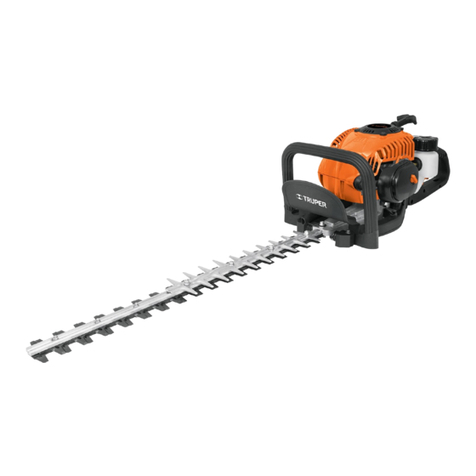
Truper
Truper COS-26X User manual

Truper
Truper DES-26C User manual

Truper
Truper PRETUL DES-25P User manual
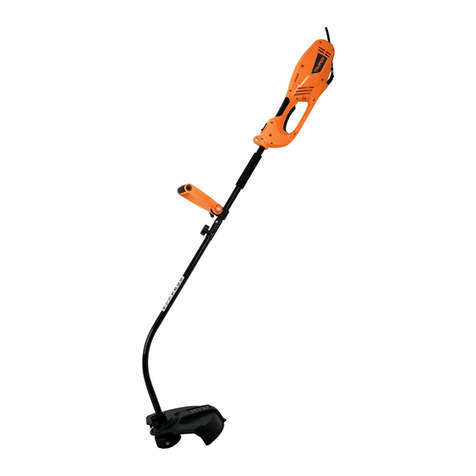
Truper
Truper DES-1000 User manual
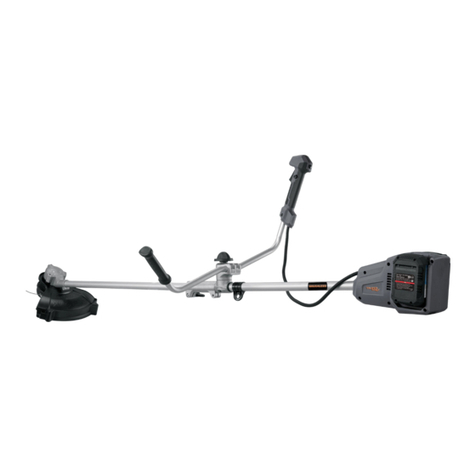
Truper
Truper MAX-40D User manual
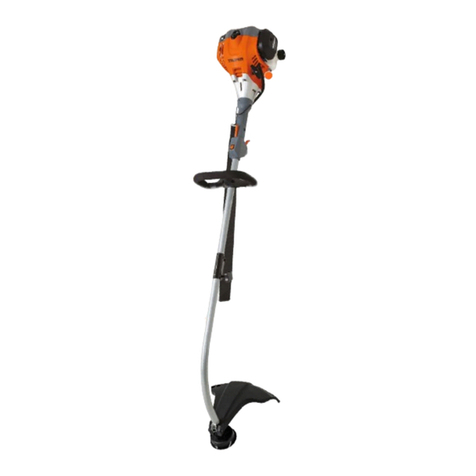
Truper
Truper DES-30C User manual
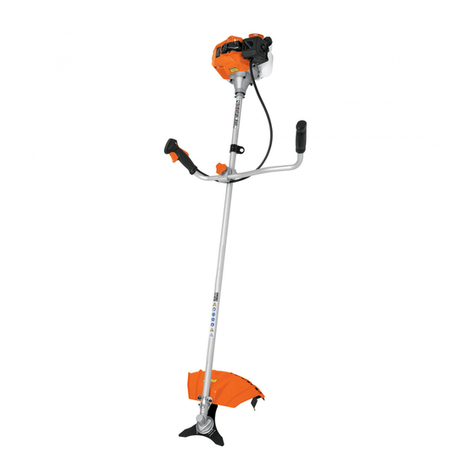
Truper
Truper DES-330 User manual
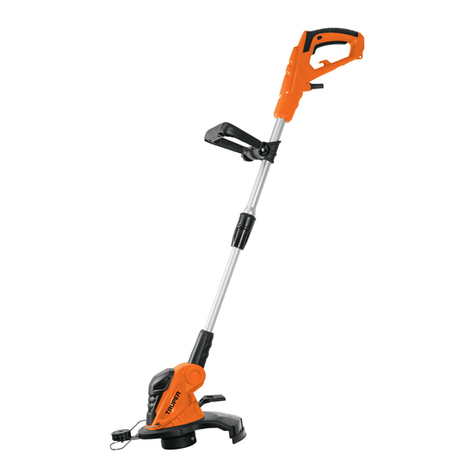
Truper
Truper DES-550 User manual
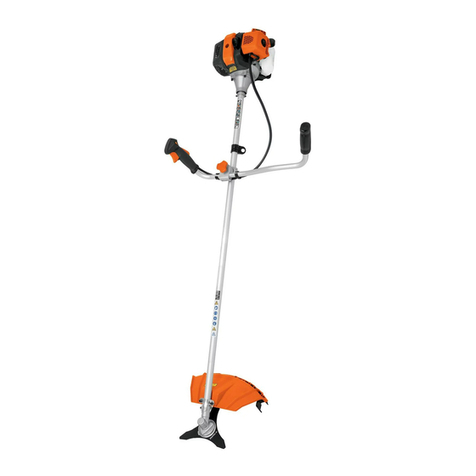
Truper
Truper DES-430 User manual
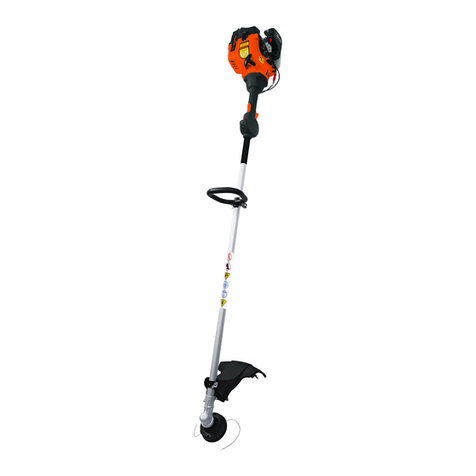
Truper
Truper DES-25R User manual
Popular Trimmer manuals by other brands
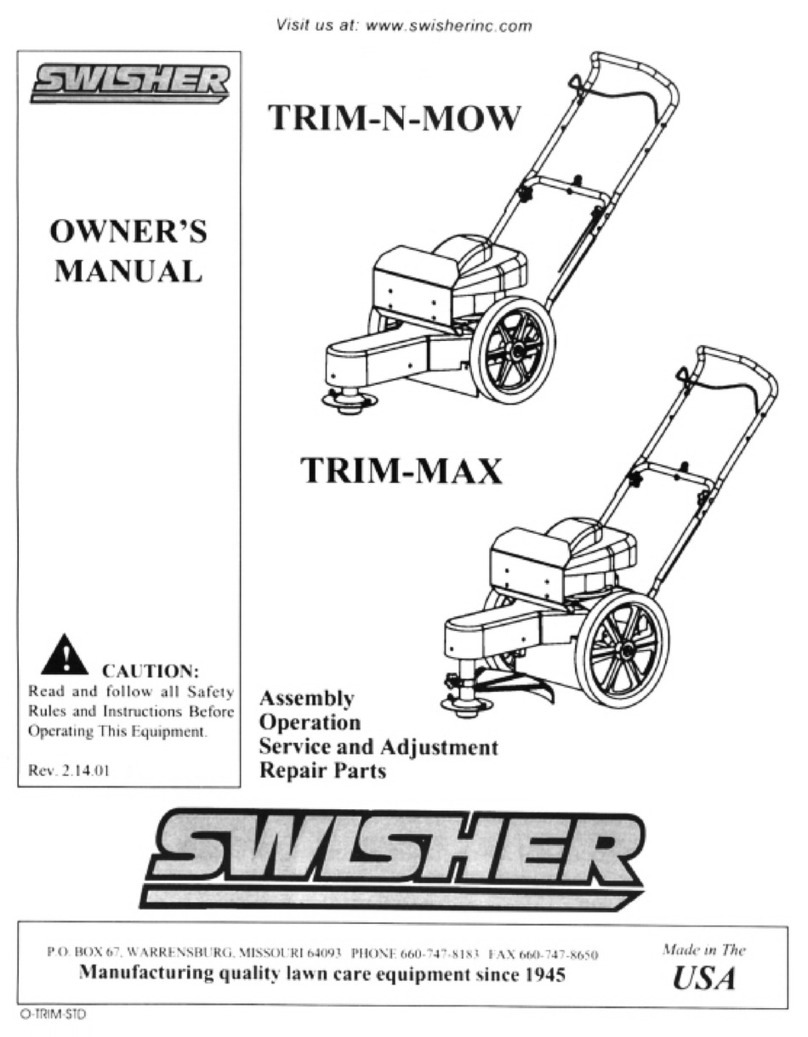
Swisher
Swisher Trim-N-Mow Assembly, operation and service manual

Hyundai power products
Hyundai power products HCB20V Original instructions

Black & Decker
Black & Decker NST1118 instruction manual
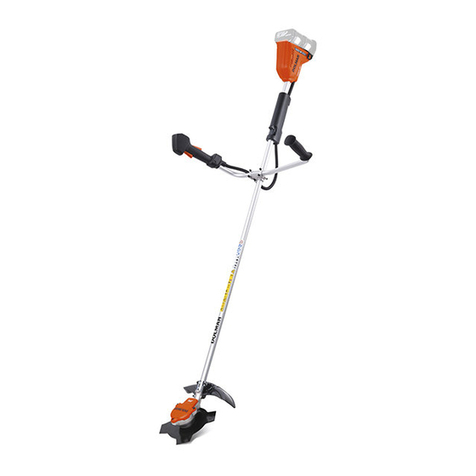
Dolmar
Dolmar AT3723UXE3 instruction manual
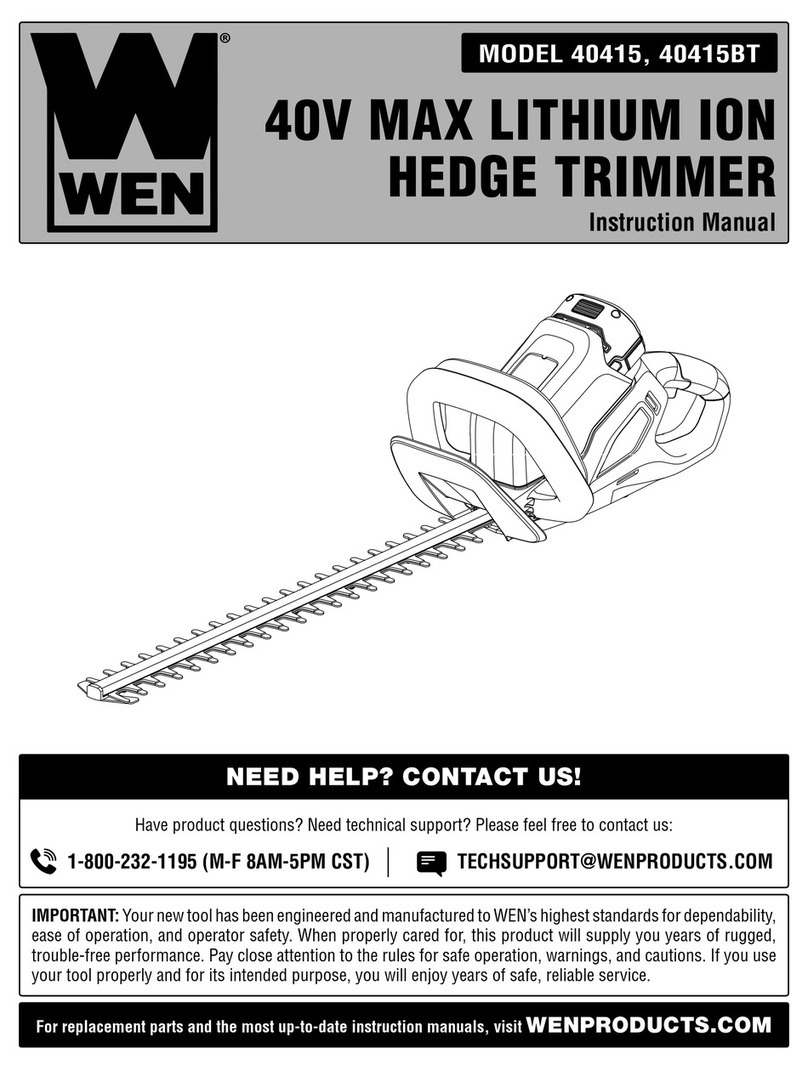
Wen
Wen 40415 instruction manual

Weed Eater
Weed Eater 545137254 instruction manual
